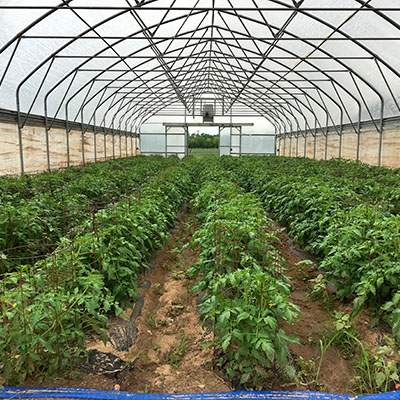By this point in summer, you probably are busy tending and harvesting your major summer crops: tomatoes, peppers, summer and winter squash, eggplant, cucumbers, and other vegetables that appreciate heat and long days. Since you know you are going to be selling those crops until frost, you might as well do a little more planting now to ensure you have a great selection until first frost and beyond. In this article, we’ll tell you about:
Quick crops you can plant now to cross-sell with your late summer produce;
Season extension tips to keep your crops coming after frost;
Advice about scheduling for specific holidays such as Halloween and Thanksgiving.
Still time to plant
Many classic vegetable dishes call for vegetables and herbs such as chives and potatoes; dill and cucumbers; tomatoes and cilantro. Unfortunately, in hot summer climates, those herbs are long gone by the time the vegetables are ready to eat. But the cooler weather of late summer and fall provides a second opportunity to grow the herbs people want with their summer veggies.
July through early August is a good time to plant these easy herbs: basil, cilantro, chives, dill, parsley, and summer savory. All can be direct seeded and will germinate readily in warm soil. Seed should be covered lightly and the soil kept moist until germination. Parsley can take 14 to 30 days to germinate, so in hot, dry weather, you may want to seed it inside and transplant outside when plants have two sets of true leaves. The others usually germinate in 7-14 days.
At market, display herbs alongside the vegetables they complement, make signs that suggest ways to use them, and provide recipes. Pesto, salsa, gazpacho, and pickles are easy summer dishes that use a lot of produce and herbs.
Herbs that are frost tolerant and can be harvested into late autumn include parsley, fennel, sage, and thyme. Fennel, sage, and parsley can be direct seeded but thyme should be started inside and transplanted. Sage and thyme dry well and make wonderful ingredients for autumn crafts such as wreaths, so be sure to plant enough for fresh and dried use.
If you grow salad mix in the fall, now is a good time to plant edible flowers. These varieties will get a good start in warm weather then produce high-quality blooms as the weather cools: Borage, Calendula, Gem Marigolds, Mexican Mint Marigolds, Nasturtiums, and Violas. Or plant one of Johnny’s edible flower collections for the widest selection. Edible flowers catch the customer’s eye and help set your salad mix apart from the rest.
Season extension for fall crops
As summer wanes, many growers stop selling and shut down for the season. That’s all the more reason to keep going! You’ll find less competition in your markets but continued strong demand as people turn their attention toward home and hearth. With some planning, you can have a good selection of produce from first frost to the beginning of winter and beyond.
Many summer crops will keep on producing for several weeks after first frost if minimal protection is used. Hoops and row cover should be kept at the ready to prevent the premature end of crops such as basil and peppers.
Or consider the versatility of a moveable caterpillar tunnel: You can put it over your summer tomatoes to keep them pproductive for several weeks longer. Meanwhile, you can plant fall lettuce, greens, broccoli, and other cool-loving crops in the adjacent plot. As hard freezes threaten, move the caterpillar off the tomatoes and over the fall crops. One moveable structure can easily pay for itself in a few seasons because it allows you to get more production over a longer period from every crop.
Quick Hoops low tunnels and high tunnels are easy and inexpensive to make from locally available materials using Johnny’s Quick Hoops benders. These structures lend months of season extension and allow you to have fresh crops coming on at a time when much of the local produce is diminishing. Start lettuce, spinach, greens, and other cool-weather crops in July and August. If it’s too hot, grow them under a low tunnel covered with shade cloth. As the weather cools, remove the shade cloth and replace it with row cover for crops you intend to harvest before winter. Quick Hoops high tunnels can be covered with greenhouse poly to extend the season for taller crops such as chard, broccoli, and cauliflower.
Here are some of the varieties and planting schedules we use for fall crops at Johnny’s research farm in Maine; adjust the timing for your own climate:
We plant lettuce outside in early August for late September harvest. The best fall varieties are Green Star, Ruby Sky, Green Forest, Helvius, Sylvesta, and Skyphos.
We plant spinach outside in August for September harvest as baby spinach, and we plant September through October under protected cover for winter and early spring harvest. Fall varieties are Racoon, Carmel, and Python.
We plant these greens under protected cover for winter harvest: Claytonia, Minutina, and Vit mache.
We seed Bolero carrots in late July for harvest in late September or early October. We seed Hakurei turnips in mid August for late September harvest. Additional seedings through September under protected cover can be harvested in fall and winter.
Scheduling for holidays
Most holidays entail eating traditional dishes, often involving seasonal vegetables. Supermarkets are experts at providing holiday-specific foods, which makes major holidays the most profitable of the year for them. Taking a cue from supermarkets, many fresh market farmers grow fall crops that will be in demand for the autumn and winter holidays.
There are many holidays between now and the end of the year. Here are the dates of the major holidays, along with suggestions for produce items that could be big sellers in the week ahead of the holiday.
Labor Day is Sept. 3, so expect strong demand for grilling and picnic ingredients such as sweet corn, tomatoes, potatoes, peppers, eggplants, and squash.
Columbus Day is Oct. 8 and if you are in an area with a strong Italian-American community, you could promote basil, radicchio, arugula, zucchini, and other Italian favorites.
Halloween is Oct. 31 and the entire month preceding it will bring increased demand for pumpkins and ornamental squash.
Thanksgiving is Nov. 22 and traditional produce items include all the cold crops and storage crops: carrots, celery, broccoli, brussels sprouts, leeks, onions, potatoes, squash, sweet potatoes. And don’t forget the herbs for the turkey stuffing: parsley, sage, rosemary, and thyme.
Chanukah is Dec. 8 - 16. It is traditional to eat foods prepared in oil such as potato or other vegetable latkes. Applesauce is served with latkes.
Christmas, Dec. 25, is associated with many kinds of food, depending on heritage. Germans, for example, often serve hot potato salad, Guatemalans serve chile rellenos, and Mexicans eat a Christmas salad of beets and fruits. Do some research about holiday foods of ethnic groups in your community.
Market Farming Basics
Still time to plant
July 1, 2012
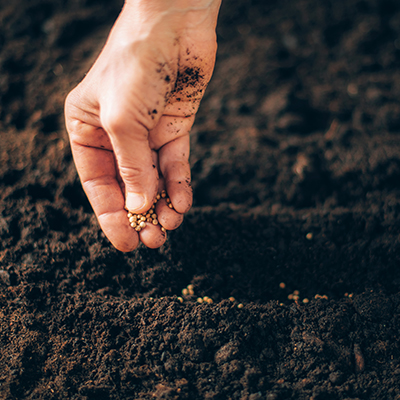
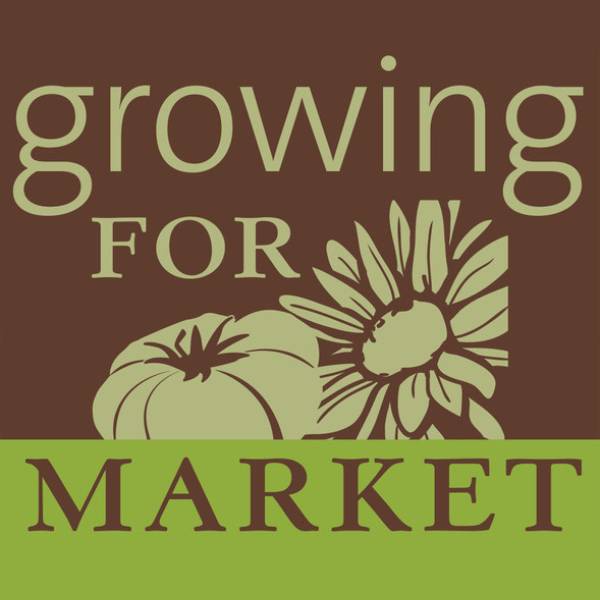
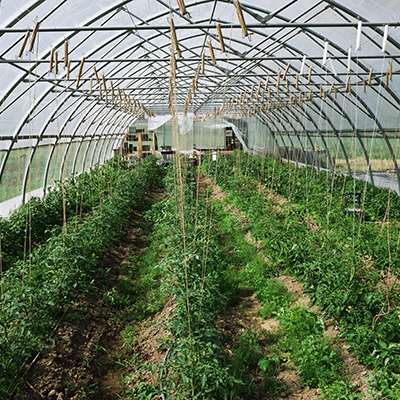
 Among successful market farms, there is a trend toward diversification and away from specialization. As growers gain experience, they tend to add new crops and markets and extend their seasons. They find ways to maximize income from everything they grow and put all their land to good use.
Among successful market farms, there is a trend toward diversification and away from specialization. As growers gain experience, they tend to add new crops and markets and extend their seasons. They find ways to maximize income from everything they grow and put all their land to good use.
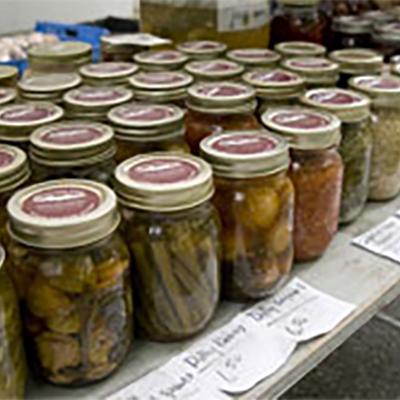
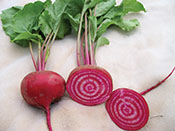 August can be a busy month. Summer crops are at their peak and fall crops need attention. It's time to look ahead to fall and winter markets. Yet, it may still be so hot you just don't want to do anything! We'll suggest some practical ideas and, we hope, provide some encouragement to keep you going.
August can be a busy month. Summer crops are at their peak and fall crops need attention. It's time to look ahead to fall and winter markets. Yet, it may still be so hot you just don't want to do anything! We'll suggest some practical ideas and, we hope, provide some encouragement to keep you going.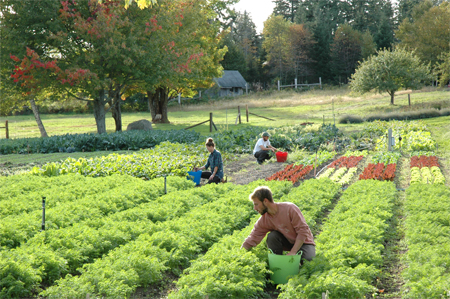 When you're new to farming, everything is so interesting and exciting that you may assume you'll remember every detail of what you are growing, where and when you planted it, and how well it performed. Veteran growers, however, know that the details start to fade quickly over the course of a busy season. That's why the most experienced and successful farmers keep careful records.
When you're new to farming, everything is so interesting and exciting that you may assume you'll remember every detail of what you are growing, where and when you planted it, and how well it performed. Veteran growers, however, know that the details start to fade quickly over the course of a busy season. That's why the most experienced and successful farmers keep careful records.
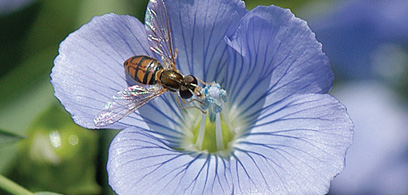 Insect pollination is essential to many vegetable and fruit crops, including tomatoes, squash, pumpkins, watermelons, blueberries, blackberries, apples, almonds, and many others. In the case of watermelons, there will be no fruit without pollination. Some vegetables don't require pollination to set fruit, but pollination by bees will result in larger and more abundant fruits. Nearly 75% of the flowering plants on Earth rely on pollinators to set seed or fruit, as well as one-third of our food crops, and most pollination is performed by honey bees, native bees, and other insects.
Insect pollination is essential to many vegetable and fruit crops, including tomatoes, squash, pumpkins, watermelons, blueberries, blackberries, apples, almonds, and many others. In the case of watermelons, there will be no fruit without pollination. Some vegetables don't require pollination to set fruit, but pollination by bees will result in larger and more abundant fruits. Nearly 75% of the flowering plants on Earth rely on pollinators to set seed or fruit, as well as one-third of our food crops, and most pollination is performed by honey bees, native bees, and other insects. 